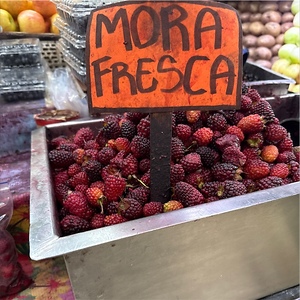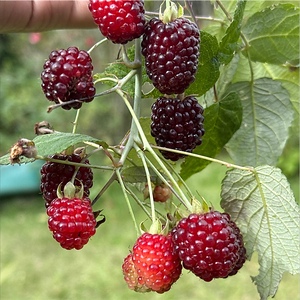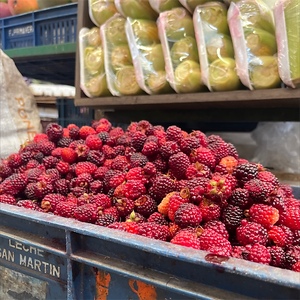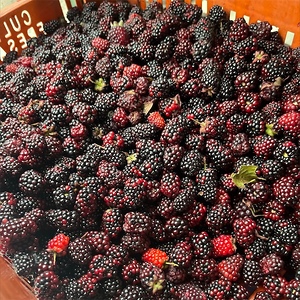


Castilla Blackberries
Estimated Inventory, lb : 0
Description/Taste
Castilla blackberries are small, averaging 1.5 to 2.5 centimeters in diameter and 2 to 4 centimeters in length, and have an oval, oblong, to ellipsoidal shape. The berries taper slightly toward the non-stem end and weigh 3 to 5 grams, topped with a green-leafed cap. Castilla blackberries are a type of aggregate fruit, meaning they are comprised of tiny, round drupelets that fuse to create the appearance of a single fruit. The surface is textured, bubbled, bumpy, smooth, and glossy, and each drupelet is taut with thin skin. Castilla blackberries ripen from green to shades of bright red, dark red, crimson, burgundy, and deep purple, and the coloring will vary depending on maturity and growing conditions. The fruit’s surface may also be covered in fine hairs or be hairless. Underneath the exterior, there is a saturated red flesh with a pulpy, aqueous, and tender consistency. The flesh also encases small, crunchy seeds and is centered around a spongy, white receptacle. Castilla blackberries are edible raw or cooked and have a bittersweet, tangy, and sour taste. The species is said to be sourer than other commercial blackberry varieties and is primarily combined with sweeteners to develop a more palatable taste.
Seasons/Availability
Castilla blackberries are available year-round, with a peak season from March to May and October to December.
Current Facts
Castilla blackberries, botanically classified as Rubus glaucus, are a South American species belonging to the Rosaceae family. The fruits grow on perennial shrubs reaching 1 to 2 meters in height, sometimes becoming larger, depending on the growing environment, and have a branching nature. There are over forty-four species of blackberries grown in Colombia. Only nine are considered edible, and Castilla blackberries are one of the most popular varieties produced on a small commercial scale. Castilla blackberries are also known as Andean blackberries, Castille berries, and Mora de Castilla. The species is hand-harvested at least 2 to 3 times per week, which is a labor-intensive process, as the fruits are delicate and can be easily damaged. Castilla blackberries are relatively unknown outside of South America. In Colombia, Castilla blackberries are grown by small farms and are favored for their intense coloring and bittersweet, sour flavor. The berries are primarily sold in fresh markets in their native growing regions for raw and cooked culinary preparations, and they are also processed into various juices, purees, and preserves.
Nutritional Value
Castilla blackberries are a source of fiber to regulate the digestive tract, vitamin C to boost the immune system, calcium to build strong bones and teeth, and magnesium to control nerve functions. The species also provides potassium to balance fluid levels within the body, iron to develop the protein hemoglobin for oxygen transport through the bloodstream, and phosphorus to repair tissues. The fruit’s dark red to purple hues indicate the presence of anthocyanins, natural compounds with antioxidant-like properties that protect the cells against free radical damage.
Applications
Castilla blackberries have a bittersweet, sour taste suited for fresh and cooked preparations. The species is often combined with sweeteners to create a more palatable flavor, but consumers appreciate the fruits for their intense nature. Castilla blackberries can be sprinkled with sugar and eaten as a snack, tossed into salads, or mixed into fruit bowls. The fruits can also be mashed onto sandwiches with cream as an afternoon snack, layered into parfaits, or used as an edible, decorative topping on various desserts. In addition to fresh preparations, Castilla blackberries are popularly simmered into jams, jellies, and other preserves. Jams can be served with cheeses on charcuterie boards, or they can be spread over toast. Castilla blackberries are also cooked into chutney, infused into sauces for roasted meats, or made into purees. The berry’s tangy taste complements sweet notes in mousses, puddings, crepes, and cakes, or they can be added to the batter for muffins and other pastries. Castilla blackberries can also be pureed and frozen into ice cream or sorbet or blended into smoothies and fruit juices. Beyond culinary uses, Castilla blackberries are dried for extended use and sprinkled over grain bowls, porridges, and salas. They can also be mixed into trail mixes. Castilla blackberries pair well with cheeses such as goat, brie, mascarpone, and ricotta, herbs including mint, basil, rosemary, and thyme, and nuts such as walnuts, almonds, and pecans. Whole, freshly picked Castilla berries should be immediately consumed for the best quality and flavor. The berries have a short shelf life and should be washed just before use. Store any unused berries in a well-ventilated container in the refrigerator’s crisper drawer.
Ethnic/Cultural Info
Castilla blackberries are celebrated in Santander, Colombia, through an annual festival known as the Festival de Mora. The event is held in Piedecuesta, Santander, and was created to promote the local cultivation and sale of the Andean blackberry. Castilla production in Santander is one of the top fruits grown in the region, and historians attribute the species’ introduction to Don Eliécer Echavarría, a farmer who traveled and found the seeds in Los Santos, noting that it originally came from Brazil. The Festival de Mora was initially run by berry growers and was a training event for farmers to view the advancements in cultivation and participate in exhibitions to network and acquire complimentary educational materials. Over time, the celebration transformed and featured live entertainment, parades, and markets featuring blackberry-centric goods such as wine, jams, sauces, and desserts. The festival also holds community cycling races to promote environmentally friendly modes of transportation.
Geography/History
Castilla blackberries are native to South America and were thought to have first arisen from Brazil. In the Early Ages, the species spread throughout South and Central America and was naturalized in tropical highland regions of the Andes Mountains. Castilla blackberries thrive in elevations between 1,500 and 3,100 meters in height and typically grow along forest edges, pastures, meadows, and fences. Historically, the species was not used on a broad scale and was mainly left alone in the wild. Over time, civilizations began cultivating the species and utilizing the fruits for various beverages and culinary preparations. Today, Castilla blackberries are found throughout Central and South America, mainly in Colombia, Ecuador, Bolivia, Brazil, Panama, Costa Rica, Honduras, and Mexico. In Colombia, where the Castilla blackberries in the photograph above were sourced, the species is grown in the departments of Santander, Risaralda, Cundinamarca, Antioquia, Huila, Narino, Tolima, and Boyaca.
Recipe Ideas
Recipes that include Castilla Blackberries. One
| Hungry Sofia |
|
Dulce de Mora |
| JP Trading |
|
Blackberry Mousse |
| Pura Vida Moms |
|
Mora Juice |












